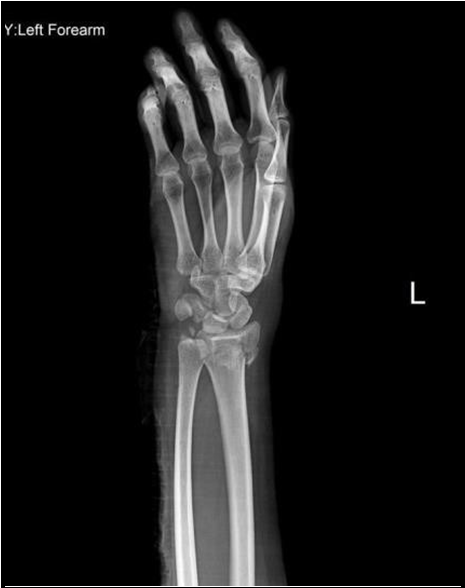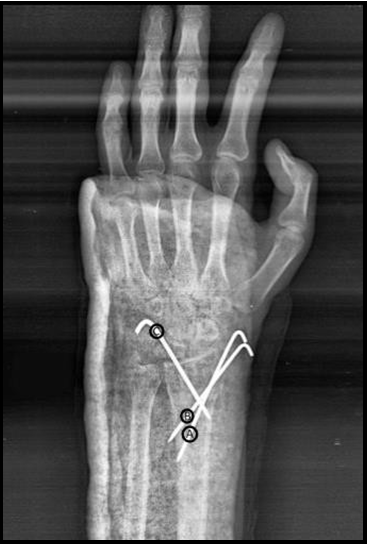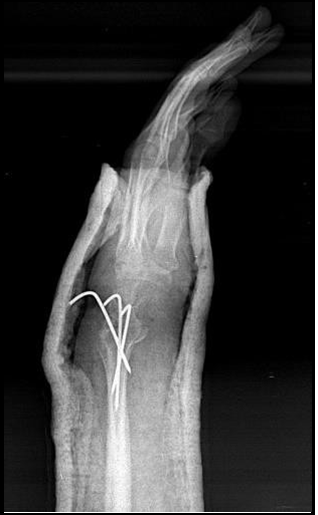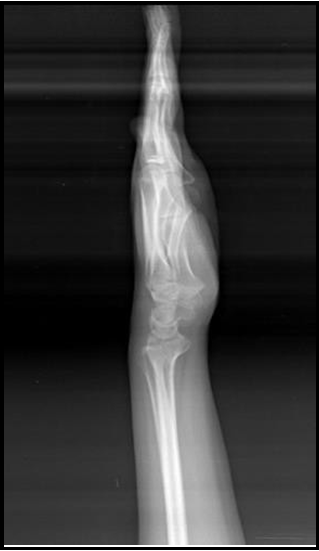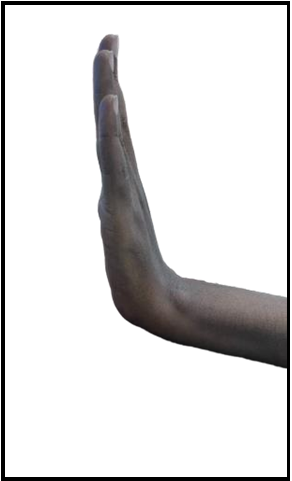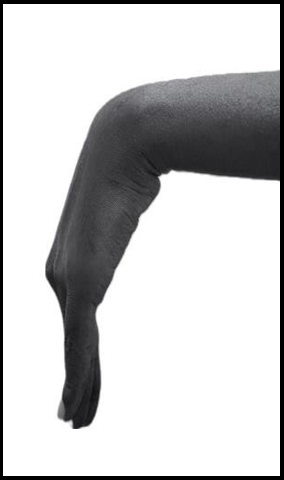Abdirizak Abdullahi Sheikdon, M.D1,2*, Abdishakur Mohamud Ahmed, M.D2, Kamaludin Dahir Osman, M.D3, Ibrahim Salad Dahir, M.D3, Intisar Ahmed Abdi, M.D4
1Orthopedic Department, Somali National University, Mogadishu, Somalia
2Orthopedic Department, Royal Hospital Mogadishu, Mogadishu, Somalia
3General Surgery Departments, Royal Hospital Mogadishu, Mogadishu, Somalia
4Anesthesia and critical care, Royal Hospital Mogadishu, Mogadishu, Somalia
*Corresponding Author: Abdirizak Abdullahi Sheikdon M.D, Department of Internal Medicine, National Cancer Institute. Bogota, Colombia.
Abstract
Background: Distal radius fractures are one of the most common traumatic injuries in orthopedics. Distal radius fracture treatment aims to restore normal function; however, the exact approach used to achieve the desired outcome remains controversial.
Case presentation: This report describes the case of a 29-year-old male with a closed distal radius fracture who was managed with closed reduction and three percutaneous pinning procedures using local anesthesia. At three months, the patient showed excellent results in flexion and extension.
Conclusions: Percutaneous pinning fixation and local anesthesia are viable alternatives to open reduction with general anesthesia in distal radius fractures.
Keywords: Local Anesthesia, Percutaneous Pinning, Distal Radius Fracture
Introduction
Distal radius fractures are one of the most common traumatic injuries in orthopedics, accounting for 8-15% of all bone injuries in adults. [1] Fractures of the distal radius in young adults are believed to cause more significant disability than Colles fractures, which are common in older people. This is likely due to the higher impact and the tendency to result in worse fractures and soft tissue injuries, as young individuals have higher functional expectations. [2]
The primary objective of fracture treatment is to achieve accurate fracture reduction and apply a fixation method that maintains the reduction. While distal radius fracture treatment aims to restore normal function, the exact method used to achieve this outcome, whether open reduction and internal fixation or closed reduction and percutaneous pinning, remains controversial. [3]
Case Report
A 29-year-old male presented to the emergency department with a history of falls while playing soccer. He complained of severe pain, deformity, and swelling in his left wrist and was unable to move his fingers. The patient had a history of a right non-displaced distal radius fracture a year before, which was managed non-operatively and resulted in positive outcomes in the wrist range of motion. He has no known medical conditions. Clinically, he was in a fair general condition; the left wrist joint was deformed posteriorly and swollen. There was tenderness and restriction on finger flexion and extension. Distal neurovascular status was intact.
Diagnosis
An X-ray was performed (as shown below in pictures 1 and 2), revealing a fracture of the distal radius with dorsal angulation and an ulnar styloid fracture. The fracture was classified as an AO/OTA 2R3A2.2.
Picture 1: pre-operative distal radius AP view
Picture 2: Pre-operative distal radius lateral view
Treatment
The selected approach involved closed reduction, percutaneous pinning of the distal radius, and casting as the treatment for the injury (as shown in pictures 3-6). The decision was made not to intervene with the tiny fragment of the ulnar styloid, assuming it had already aligned correctly and because of its small size.
The procedure was explained to the patient, stating that local anesthesia would be used for the reduction and the K-wire fixation. In the event of failure, general anesthesia would be administered. The patient provided informed consent. The patient's left arm was cleaned, and sterile drapes were placed over the area. Then, local anesthesia was administered by injecting three ml of 2% lidocaine without epinephrine around the fracture site as a hematoma block. The fracture was manually reduced under fluoroscopy guidance.
Similarly, one ml of 2% lidocaine was injected at each pin site, including a joystick pin for reduction, and an additional one ml injection was given at the pin (A) exit point (Picture 3). Therefore, a total of eight ml of lidocaine was used. The reduction was confirmed on X-ray, and the wrist was immobilized with a plaster cast.
Picture 2: post-operative distal radius AP view
Picture 3: post-operative distal radius lateral view
Picture 4: Intra-operative distal radius pinning
Picture 5: Intra-operative distal radius pinning
Outcome
The patient tolerated the procedure, and no complications were observed. Pain relief was experienced, and the X-ray confirmed a satisfactory alignment of the fracture. The patient was advised to keep the cast on for six weeks and return for follow-up X-rays in the second and sixth weeks. Additionally, instructions were provided on proper cast care and vigilance for potential complications like infection and compartment syndrome.
Follow-up
During the follow-up appointment in the second week after the operation, the patient's X-rays showed no reduction loss, indicating that the fracture aligned correctly. In the subsequent visit in the sixth week, both the pins and cast were removed, and X-rays confirmed that the fracture was healing well without any loss or reduction.
Three months postoperatively, the patient reported being able to perform a wide range of motion without experiencing any pain (as shown in pictures 9 and 10). X-rays revealed complete healing of the fracture (as shown in pictures 7 and 8). The patient received advice to continue with wrist range of motion exercises and was instructed to seek medical attention if any issues arise.
Picture 6: Three months post-operative distal radius AP view
Picture 7: Three months post-operative distal radius lateral view
Picture 8: Wrist extension at three months
Picture 9: Wrist flexion at three months
Discussion
Local anesthesia has been widely used for hand surgeries and, at times, wrist fixations. In many cases, patients may not need extensive preoperative evaluations. The advantage of local anesthesia is that it allows surgeries to be performed while the patient is awake, and they can leave the operating room right after the procedure.[4-6] This technique serves as a viable alternative for patients who are not suitable for general anesthesia and significantly reduces waiting times for surgeries. [7] percutaneous pin fixation has demonstrated similar long-term outcomes to volar locking plate fixation. [8]
Conclusion
Local anesthesia is a simple and effective technique that can facilitate the closed reduction of fractures. It is a minimally invasive procedure that can be quickly and easily performed in the emergency department, outpatient setting, and operating room. Furthermore, percutaneous pins are a cost-effective and viable fixation method for distal radius fractures. In this case, the combination of local anesthesia and percutaneous pins was utilized to successfully reduce and stabilize a Colles fracture, resulting in outstanding alignment and functional outcomes.
Acknowledgments
I thank Almighty Allah for this work and am grateful for both the surgery outcome and the case report.
Disclosure
I hereby declare that the disclosed information is correct and that I am not aware of any other situation of real, potential, or apparent conflict of interest.
Funding: This case report received no funding from any source.
Ethical approval and consent to participate:
The hospital's Research Ethics Committee approved the research, and administrative clearance was sought from the Department of Orthopedics and Administration Office, Royal Hospital Mogadishu. The participant gave written informed consent for the surgery.
Consent for publication: written informed consent was obtained to publish this case report and any accompanying images. A copy of the written consent is available for review by the Editor-in-chief of this journal.
Availability of supporting data: all files supporting this case are available upon request.
References
- Pogue DJ, Viegas SF, Patterson RM, Peterson PD, Jenkins DK, et al. (1990) Effects of distal radius fracture malunion on wrist joint mechanics. J Hand Surg Am. 15(5): 721-7.
- Gliatis JD, Plessas SJ, Davis TR (2000) Outcome of distal radial fractures in young adults. Journal of Hand Surgery (European Volume). 25(6): 535-43.
- Meena S, Sharma P, Sambharia AK, Dawar A (2014) Fractures of distal radius: an overview. J Family Med Prim Care. 3(4): 325-32.
- Mckee DE, Lalonde DH, Thoma A, Dickson L (2015) Achieving the optimal epinephrine effect in wide awake hand surgery using local anesthesia without a tourniquet. Hand (N Y). 10(4): 613-5.
- Steiner MM, Calandruccio JH (2018) Use of wide-awake local anesthesia no tourniquet in hand and wrist surgery. Orthop Clin North Am. 49(1): 63-68.
- Tahir M, Chaudhry EA, Zaffar Z, Anwar K, Mamoon MAH, et al. Fixation of distal radius fractures using wide-awake local anaesthesia with no tourniquet (WALANT) technique: A randomized control trial of a cost-effective and resource-friendly procedure. Bone Joint Res. 9(7): 429-439.
- Yi LM, Ahmad AA, Ruslan SR, Abdullah S, Ahmad AR (2020) Plating distal radius fractures using wide-awake local anesthesia no tourniquet (WALANT) versus general anesthesia: a cohort study. Journal of Hand Surgery Global Online. 2(6): 331-338.
- Rupp M, Cambon-Binder A, Alt V, Feron JM (2019) Is percutaneous pinning an outdated technique for distal radius fractures? Injury. 50 Suppl 1: S30-S5.




